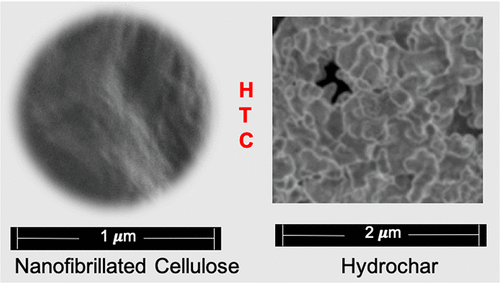当前位置:
X-MOL 学术
›
ACS Sustain. Chem. Eng.
›
论文详情
Our official English website, www.x-mol.net, welcomes your feedback! (Note: you will need to create a separate account there.)
Hydrothermal Carbonization of Nanofibrillated Cellulose: A Pioneering Model Study Demonstrating the Effect of Size on Final Material Qualities
ACS Sustainable Chemistry & Engineering ( IF 8.4 ) Pub Date : 2020-01-23 , DOI: 10.1021/acssuschemeng.9b05928 Shelly Johnson 1 , RH Fitri Faradilla 2 , Richard A. Venditti 1 , Lucian Lucia 1 , Marko Hakovirta 1
ACS Sustainable Chemistry & Engineering ( IF 8.4 ) Pub Date : 2020-01-23 , DOI: 10.1021/acssuschemeng.9b05928 Shelly Johnson 1 , RH Fitri Faradilla 2 , Richard A. Venditti 1 , Lucian Lucia 1 , Marko Hakovirta 1
Affiliation

|
The morphological and physical properties of hydrochar from the hydrothermal carbonization of nanofibrillated cellulose (NFC) are herein described; it was found that the initial starting structure influences the final hydrochar structure to a great extent, as observed by a scanning electron microscope (SEM). Effects of temperature and heating time on the resulted hydrochars were also explored. For comparison purposes, fully bleached macroscopic softwood pulp fibers with a composition similar to the NFC were also converted into hydrochar and characterized. The carbonization of the NFC started at >200 °C although time did not affect the properties of the hydrochar when the hydrothermal carbonization (HTC) was performed at 250 °C. The SEM images of the NFC hydrochar revealed broad nanoscale topological features that may be characterized as nodule-filled surfaces connecting continuously, without a bulk surface as the base, where the nodule dimensions range from 2 to 400 nm. The nanostructure of the NFC did not modify the elemental composition of the resultant hydrochar relative to the hydrochar from softwood. However, the morphology of hydrochar from NFC was different from the hydrochar from the softwood fibers, indicating that there is an advantage to using nanostructured starting material. The NFC hydrochar also had much higher pore volume (0.91 cm3/g) and average pore size (127.1 nm) than the softwood fiber (0.01 cm3/g and 4.5 nm, respectively).
中文翻译:

纳米原纤化纤维素的水热碳化:一个开创性的模型研究,表明尺寸对最终材料质量的影响
本文描述了由纳米原纤化纤维素(NFC)的水热碳化得到的炭的形态和物理性质。如通过扫描电子显微镜(SEM)所观察到的,发现初始起始结构在很大程度上影响了最终的水炭结构。还探讨了温度和加热时间对生成的炭的影响。为了进行比较,将具有类似于NFC成分的完全漂白的宏观针叶木浆纤维也转化为水焦炭并进行了表征。NFC的碳化开始于> 200°C,尽管在250°C进行水热碳化(HTC)时,时间不会影响烃的性质。NFC碳氢化合物的SEM图像显示了宽广的纳米尺度拓扑特征,其特征可能是结节填充的表面连续连接,而没有块状表面作为基础,结节尺寸范围为2至400 nm。NFC的纳米结构相对于软木中的水炭而言,不会改变所得水炭的元素组成。但是,来自NFC的水炭的形态不同于来自软木纤维的水炭的形态,这表明使用纳米结构的起始材料是有优势的。NFC水焦炭的孔隙体积也更大(0.91 cm NFC的纳米结构相对于软木中的水炭而言,不会改变所得水炭的元素组成。但是,来自NFC的水炭的形态不同于来自软木纤维的水炭的形态,这表明使用纳米结构的起始材料是有优势的。NFC水焦炭的孔隙体积也更大(0.91 cm NFC的纳米结构相对于软木中的水炭而言,不会改变所得水炭的元素组成。但是,来自NFC的水炭的形态不同于来自软木纤维的水炭的形态,这表明使用纳米结构的起始材料是有优势的。NFC水焦炭的孔隙体积也更大(0.91 cm3 / g)和平均孔径(127.1 nm)比软木纤维(分别为0.01 cm 3 / g和4.5 nm)。
更新日期:2020-01-23
中文翻译:

纳米原纤化纤维素的水热碳化:一个开创性的模型研究,表明尺寸对最终材料质量的影响
本文描述了由纳米原纤化纤维素(NFC)的水热碳化得到的炭的形态和物理性质。如通过扫描电子显微镜(SEM)所观察到的,发现初始起始结构在很大程度上影响了最终的水炭结构。还探讨了温度和加热时间对生成的炭的影响。为了进行比较,将具有类似于NFC成分的完全漂白的宏观针叶木浆纤维也转化为水焦炭并进行了表征。NFC的碳化开始于> 200°C,尽管在250°C进行水热碳化(HTC)时,时间不会影响烃的性质。NFC碳氢化合物的SEM图像显示了宽广的纳米尺度拓扑特征,其特征可能是结节填充的表面连续连接,而没有块状表面作为基础,结节尺寸范围为2至400 nm。NFC的纳米结构相对于软木中的水炭而言,不会改变所得水炭的元素组成。但是,来自NFC的水炭的形态不同于来自软木纤维的水炭的形态,这表明使用纳米结构的起始材料是有优势的。NFC水焦炭的孔隙体积也更大(0.91 cm NFC的纳米结构相对于软木中的水炭而言,不会改变所得水炭的元素组成。但是,来自NFC的水炭的形态不同于来自软木纤维的水炭的形态,这表明使用纳米结构的起始材料是有优势的。NFC水焦炭的孔隙体积也更大(0.91 cm NFC的纳米结构相对于软木中的水炭而言,不会改变所得水炭的元素组成。但是,来自NFC的水炭的形态不同于来自软木纤维的水炭的形态,这表明使用纳米结构的起始材料是有优势的。NFC水焦炭的孔隙体积也更大(0.91 cm3 / g)和平均孔径(127.1 nm)比软木纤维(分别为0.01 cm 3 / g和4.5 nm)。



























 京公网安备 11010802027423号
京公网安备 11010802027423号